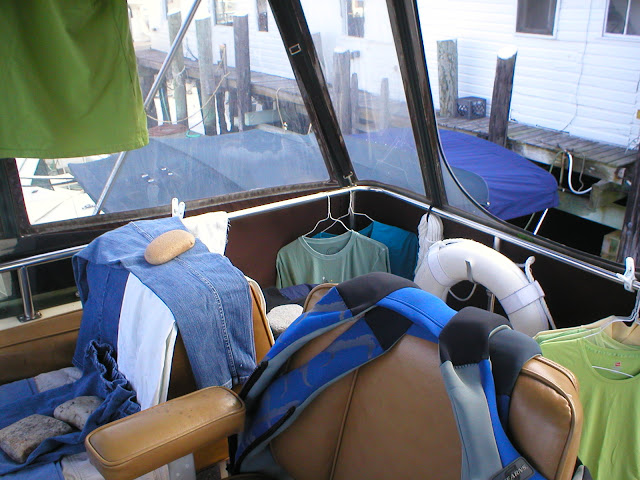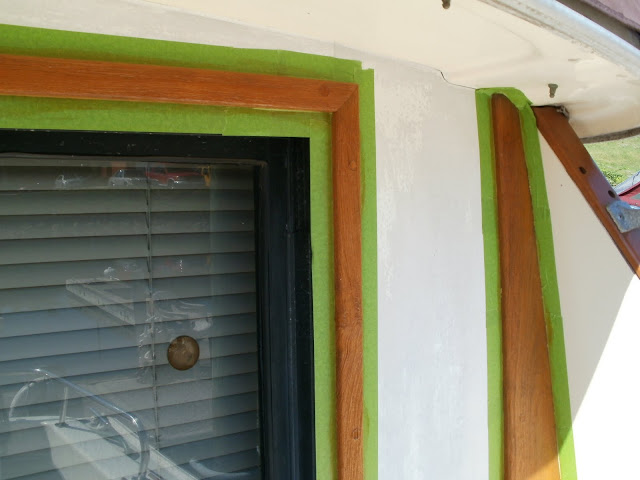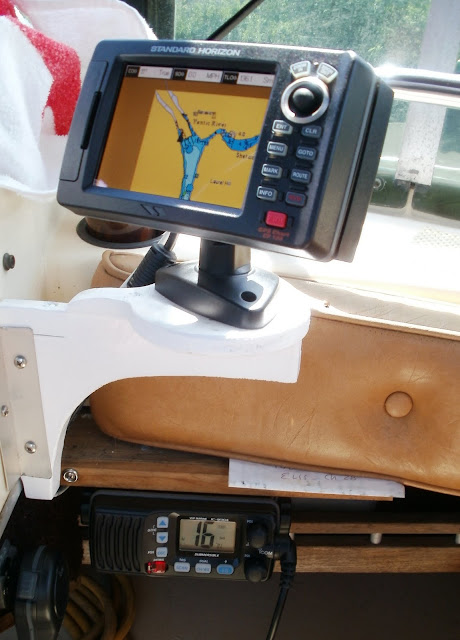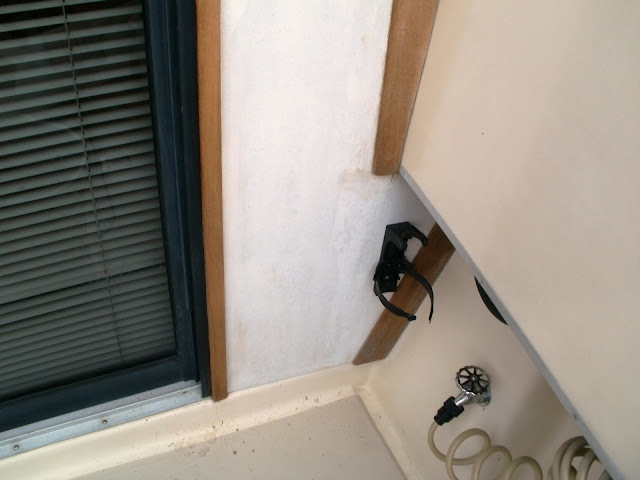Our annual trip to Block Island began with the arrival in Norwich of our friend Ellen Creighton who took the ferry from Orient Point. We loaded up our stuff and headed downriver to get gas at the Shennecossett Yacht Club in Groton. There we took on 151 gallons of gas (expensive, we know, but that's the price of boating these days) and then went east in Fisher's Island Sound and went out at Watch Hill. It is 15 miles to Block Island from there.
We were aware that the weather wasn't good and in fact there was a small craft advisory posted for Block Island Sound. The first mile or so wasn't bad under a bright sun but as we got farther out, we began to encounter some large rollers from the southwest. We surfed through them but had to pay particular attention to keeping our exact heading because if we drifted off it, we either turned into the rollers or went broadside to them, neither very comfortable. Frances was below, trying to hold the furniture in place and Ellen stayed on the bridge with Bill.
About five miles out, our starboard engine quit and with the seas that big, we were unable to go below and see what the problem was. We increased power on the port engine and continued out at about 9 miles per hour. It was quite a struggle keeping our heading on one engine, but we did. About five miles from Block, we heard another boat also heading for Block reporting dense fog on the radio. What else could happen?
As we got closer to New Harbor inlet, the fog began to close in. We managed to stay on our course and watched for Block to show up on the radar, which it eventually did. As we got closer to the inlet, the density of the fog increased and it was a relief when Ellen spotted the red sea buoy at the inlet. We motored in but found a big wind still blowing from the southwest in Great Salt Pond. We were unable to steer effectively against it as we entered the mooring field and ended up trying to anchor in very shallow water at the north side of the pond. Luckily, another boater saw our situation and called TowBoat US. Doug, the TowBoat Captain, arrived and towed us to an empty mooring. That was an expensive tow but it was accomplished before we did any damage to the boat.
Once on the mooring, we sorted out the boat's interior and when we tried the starboard engine, it started instantly. Oh well, another engine mystery to solve. We decided to take the launch ashore and get some dinner and figure out the engine problem in the morning.
The next morning, after a good snooze, we changed the fuel filter/water separator cartridge on the starboard, engine, started up and left the mooring for Payne's.
With both engines running fine, we managed to dock at Payne's with only a minor bump to our inflatable. We were "around back" at Payne's, which is not our favorite spot but comfortable enough with some nice neighbors.
We stayed at Payne's for five days, taking a while to get on "island time," visiting one of our dockmates at a mooring in our inflatable and generally doing what everyone does there; go to the shops, take walks,get to the library and generally enjoy what turned out to be pretty good weather.
As always, we met some interesting people. One couple arrived in a nicely restored Chris-Craft that everyone commented on. Once back home, we consulted Jerry Conrad's book, Chris-Craft: the Essential Guide because Brian, the boat's owner, had only identified as a "1953 Chris-Craft." While we can't be absolutely sure, because Chris-Craft made a lot of boats of this style and type, Brian's boat appeared to be a 25 ft. Enclosed Cruiser, a boat that was made from 1951 to 1953. Chris-Craft made 224 of these popular boats during those years and we suspect that Brian has one of the few left. We wish him many good years with it. He keeps it at Fort Rachel in Mystic, where we like to visit. Hopefully we will see him there in the future.
After years of being the same old place, Payne's has changed. Cliff and Sands have built a beautiful big pine paneled dining room above a portion of the old building. Now you can walk upstairs and watch all the action at the dock.
On Tuesday, we left Block Island. Our plan was to head west to Greenport, Long Island and drop off Ellen. The weather was perfect and the cruise down Block Island Sound was wonderful except, after about two hours at our cruising speed, the starboard engine stopped again. We were close enough to Greenport by then and as we entered the Greenport breakwater, we restarted the starboard engine and docked without drama. This problem was getting annoying. Ellen was kind enough to take us to Larry's Lighthouse Marine in Riverhead where we purchased some extra fuel filters. But when we examined the old filter it was clean as was the little filter at the fuel inlet on the carb.
On Wednesday morning, we left Greenport for home. The starboard engine ran flawlessly until we were about to enter New London harbor (again about two hours of running time) but this time we simply throttled it back and took it out of gear, where it idled happily as we ran up the river on our trusty port engine. Once again, the starboard engine worked fine for docking, so that's a problem that we'll have to figure out.
We have one common 220-gallon fuel tank feeding both engines so it's not bad fuel. What runs perfectly for two hours and then causes the engine to lose power? We suspect the ignition coil, since they do fail when they get hot. We have since replaced it, although it was replaced last summer on that same engine. Everything on that stinkin' starboard engine has been replaced, including rebuilding the carb. We had three bad coils over three years on, coincidentally, the starboard engine, on our old Chris-Craft, so maybe that's it.
The issue now is that we'll have to take a two-hour plus cruise to see if the coil was the problem. Isn't boating fun?
Just for the record, our Norwich-Block Island-Greenport-Norwich trip covered 148.9 miles. If we can believe the fuel gauge, that consumed about 150 gallons of fuel so we're running about one mile per gallon.































